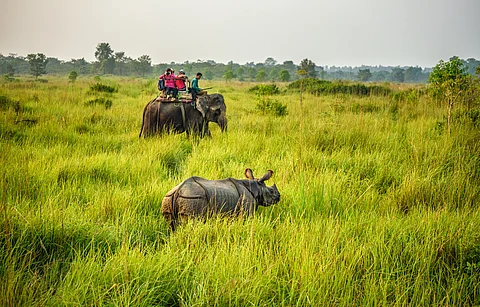

The IUCN-TRAFFIC report commends India and Nepal for their enhanced monitoring and surveillance efforts, which have significantly curbed rhino poaching.
The report highlights Nepal's legal actions against poachers and notes the steady growth in rhino populations, emphasizing the success of focused protection strategies in South Asia.
A report by the International Union for Conservation of Nature (IUCN) and TRAFFIC has credited ‘strengthened monitoring and surveillance’ as having protected India and Nepal’s rhinos from the scourge of poaching.
The report particularly highlighted Nepalese convictions of individuals involved in poaching, even as it praised the gains made in South Asia vis-à-vis rhino conservation.
By the end of March 2025, the greater one-horned rhinos (Rhinoceros unicornis) had an estimated population of 4,075, with 3,323 in India and 752 in Nepal. “This was slightly higher than that reported at CoP19 (4,014 greater one-horned rhinos), due to a population increase of 61 greater one-horned rhinos,” noted the report.
It added that since 2007, rhino populations in India and Nepal have shown steady growth. “In India, the number of greater one-horned rhinos rose from 2,150 in 2007 to 3,323 by 2024, reflecting successful conservation efforts. Nepal’s population of the same species also grew consistently, from 413 in 2007 to 752 in 2024,” according to the analysis.
These trends highlight both the success of focused protection in India and Nepal, it added.
The attempts to prevent rhino poaching in India and Nepal helped in reducing the numbers of such incidents.
In India, nine greater one-horned rhinos were illegally killed between January 2021 and December 2024. In Nepal, four greater one-horned rhinos were killed during the same period.
“Despite the ongoing threat from poaching to the greater one-horned rhino (R. unicornis), both India and Nepal have strengthened surveillance and monitoring efforts to prevent further incidents,” the analysis noted.
It particularly cited the case of Nepal. Between January 2022 and 30 April 2025, enforcement efforts in Chitwan National Park led to the arrest of 52 suspects in connection with crimes against the greater one-horned rhino.
“During this time, seven criminal cases were filed, naming 33 individuals. In three of those cases, Nepalese courts convicted 18 of the accused, demonstrating a strong legal response to rhino-related offences,” the document noted.
These cases, it said, highlighted the growing capacity of enforcement agencies in Asian rhino range states to investigate, prosecute, and penalise wildlife crimes. “However, they also underscore the ongoing threat that poaching poses and the critical importance of sustained monitoring and legal follow-through.”
Still, sustainable funding is urgently needed in Asian rhino range states, particularly in Indonesia, to improve law enforcement and protect the Critically Endangered Javan (R. sondaicus) and Sumatran rhinos (D. sumatrensis), according to the report.
The report, titled African and Asian Rhinoceroses – Status, Conservation and Trade, was commissioned by the Secretariat of the Convention on International Trade in Endangered Species of Wild Fauna and Flora (CITES).
It was prepared by the IUCN Species Survival Commission’s African Rhino Specialist Group, Asian Rhino Specialist Groups and TRAFFIC.